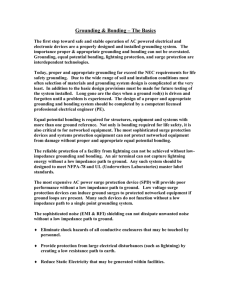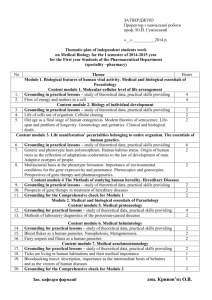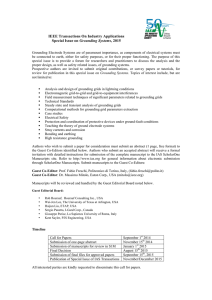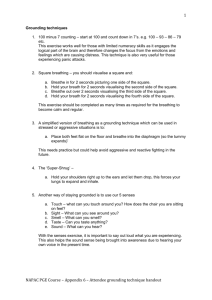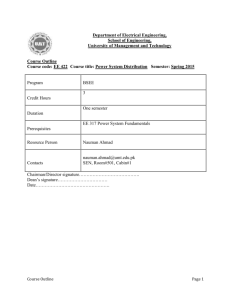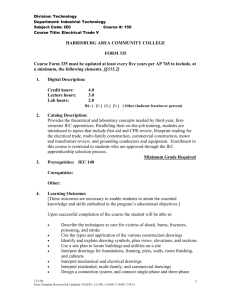26_05_26 - Brown University
advertisement
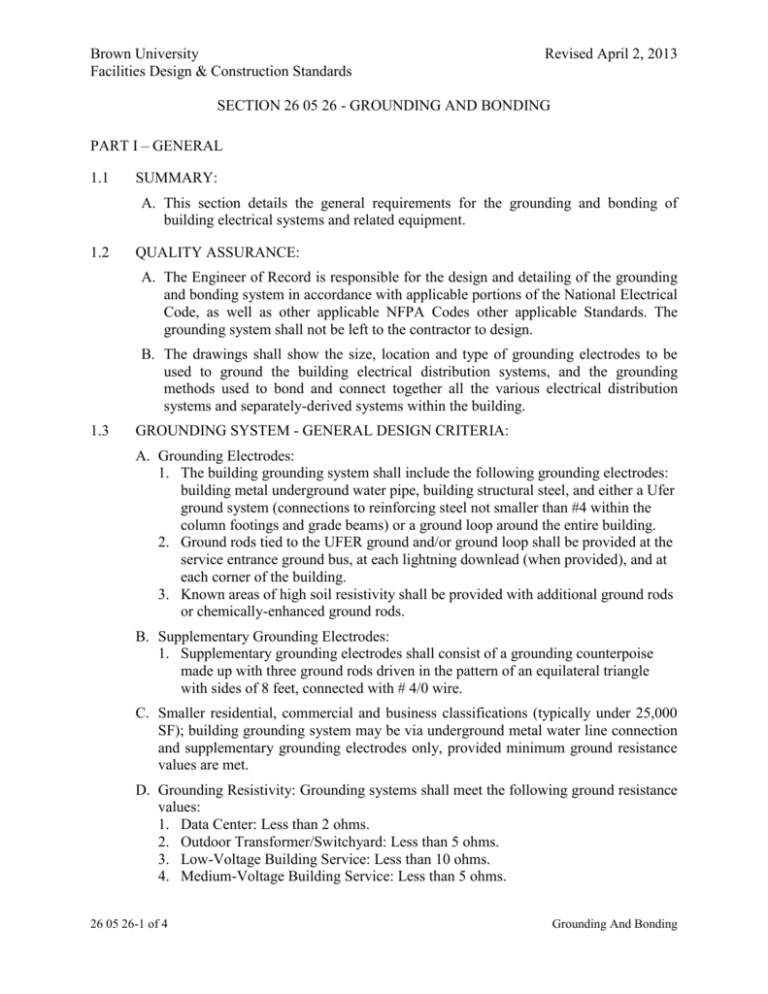
Brown University Facilities Design & Construction Standards Revised April 2, 2013 SECTION 26 05 26 - GROUNDING AND BONDING PART I – GENERAL 1.1 SUMMARY: A. This section details the general requirements for the grounding and bonding of building electrical systems and related equipment. 1.2 QUALITY ASSURANCE: A. The Engineer of Record is responsible for the design and detailing of the grounding and bonding system in accordance with applicable portions of the National Electrical Code, as well as other applicable NFPA Codes other applicable Standards. The grounding system shall not be left to the contractor to design. B. The drawings shall show the size, location and type of grounding electrodes to be used to ground the building electrical distribution systems, and the grounding methods used to bond and connect together all the various electrical distribution systems and separately-derived systems within the building. 1.3 GROUNDING SYSTEM - GENERAL DESIGN CRITERIA: A. Grounding Electrodes: 1. The building grounding system shall include the following grounding electrodes: building metal underground water pipe, building structural steel, and either a Ufer ground system (connections to reinforcing steel not smaller than #4 within the column footings and grade beams) or a ground loop around the entire building. 2. Ground rods tied to the UFER ground and/or ground loop shall be provided at the service entrance ground bus, at each lightning downlead (when provided), and at each corner of the building. 3. Known areas of high soil resistivity shall be provided with additional ground rods or chemically-enhanced ground rods. B. Supplementary Grounding Electrodes: 1. Supplementary grounding electrodes shall consist of a grounding counterpoise made up with three ground rods driven in the pattern of an equilateral triangle with sides of 8 feet, connected with # 4/0 wire. C. Smaller residential, commercial and business classifications (typically under 25,000 SF); building grounding system may be via underground metal water line connection and supplementary grounding electrodes only, provided minimum ground resistance values are met. D. Grounding Resistivity: Grounding systems shall meet the following ground resistance values: 1. Data Center: Less than 2 ohms. 2. Outdoor Transformer/Switchyard: Less than 5 ohms. 3. Low-Voltage Building Service: Less than 10 ohms. 4. Medium-Voltage Building Service: Less than 5 ohms. 26 05 26-1 of 4 Grounding And Bonding Brown University Facilities Design & Construction Standards 1.4 Revised April 2, 2013 BUILDING GROUNDING SYSTEM - DETAILED DESIGN CRTIERIA: A. Main Building Electric Rooms: provide a copper ground bus, which serves as the common grounding electrode conductor. This ground bus is to be utilized as the common grounding and bonding point for the incoming electrical service grounds, supplementary grounding electrode connections and as the common grounding point for connection and bonding of other building systems, such as telecommunications, lightning protection and various separately derived electrical systems. 1. Medium-Voltage Substation and Main Electric Rooms: For buildings with medium-voltage (over 600 VAC) services and /or distribution equipment: install a continuous grounding bus; ground bus shall be 2 inch by 1/4 inch hard drawn copper bar. Attach ground bus to the wall, at 30 inches above the floor, with standoff insulators. The ground bus shall be located behind the high voltage loop switches and extend the entire length of at least two walls inside the room so that it is accessible for connections. 2. Low Voltage Building Main Electric Rooms: for buildings with low-voltage incoming electric services, provide a 2 inch by 1/4 inch x minimum 24” long hard drawn copper ground bus bar. Attach ground bus to the wall, at 30 inches above the floor, with standoff insulators. B. Electrical distribution rooms and closets (with multiple distribution panels and stepdown transformers installed): 1. Install a 2 inch by 1/4 inch x minimum 12” long hard drawn copper ground bus bar, mounted on standoff insulators. 2. Connect local ground bus back to main electric service room ground bus. C. Telecomm rooms: 1. Install a 2 inch by 1/4 inch x minimum 12” long hard drawn copper ground bus bar, mounted on standoff insulators. 2. Connect local ground bus back to main electric service room ground bus. D. Miscellaneous: 1. A common grounding electrode conductor may be utilized for connection of multiple ground buses in larger buildings that contain multiple electric rooms and Telecom rooms. 2. Isolated ground conductors, if required, shall be connected to the building ground system only at its separately-derived supply transformer grounding location, per IEEE Std.1100 guidelines. Isolated ground distribution panels shall include a separate isolated ground bus and a bonded equipment ground bus. 3. Coordinate telecommunications and data processing systems grounding system design so that single-point grounding is ensured. 4. Electrical equipment enclosures (transformer case, etc.) shall not be used as a grounding path. 5. Grounding conductors shall be bare copper, or 600-volt insulated wire, installed in conduit. 6. At each separately-derived system, such as a transformer, the bonding jumper and grounding electrode conductor connection shall be located within the same device. In the case of a unitized secondary substation the connection shall be in 26 05 26-2 of 4 Grounding And Bonding Brown University Facilities Design & Construction Standards Revised April 2, 2013 the switchboard section just before the main breaker. 7. Where individual transformers (less than 300 KVA) and an associated switchboard or panelboard is used the bonding jumper connection shall be made in the transformer enclosure. 8. Medium voltage distribution and service transformers, switchgear and unit substations to each be provided with two independent grounding connections. E. TRANSFORMER GROUNDS: 1. Building Service Transformers: Ground secondary neutrals separately from the neutral ground at the service main, unless close coupled in unit substation construction. 2. Low Voltage Transformers: Ground secondary neutrals in the low-voltage service equipment, per NEC for services. F. EQUIPMENT GROUNDS: 1. Install a separate ground conductor with all feeders and branch circuits. Reliance on the conduit as the grounding means is unacceptable. Ground to the cabinet of the panelboard or a non-insulated ground bus. The neutral bar of the distribution panel or switchboard shall not be used for equipment grounds. 2. Provide bonding bushings on conduit fittings for all feeders rated over 200 amps. 3. Equipment grounds and the identified neutral shall not be electrically interconnected on the building side of the service ground. 4. Provide external grounding conductors for flexible liquid-tight metal conduit fittings. G. CONVENIENCE OUTLETS: 1. Provide a wired ground path from the device-grounding pole to the source distribution panel. 2. Provide ground fault interrupter outlets in wet conditions and where required by NEC and other related codes. H. EXTERIOR LIGHTING: 1. For large site lighting and parking lot poles (over 15 feet height), provide supplementary ground rod and connection at each pole. 2. All underground lighting circuits for site lighting shall contain a dedicated ground copper wire. 1.5 MATERIALS: A. All grounding materials shall be copper B. Equipment grounding conductors: copper C. Underground grounding connections: exothermic welded. D. Above ground connections: exothermic welded or bronze mechanical connectors, suitable for grounding and bonding applications, in configurations required for particular installation. E. Ground rods: 10 foot by 3/4 inch copper clad steel 26 05 26-3 of 4 Grounding And Bonding Brown University Facilities Design & Construction Standards Revised April 2, 2013 F. Ground Wells: 1. Well Pipe: 8 inches NPS by 24 inch long fiberglass pipe with belled end. 2. Well Cover: Cast iron with legend "GROUND" embossed on cover. PART 2 - PRODUCTS Not Used PART 3 - EXECUTION 3.1 FIELD QUALITY CONTROL AND TESTING: A. Inspect and test grounding system in accordance with NETA ATS, and submit a written report of the test results for Engineer of Record review and inclusion in the O & M Manuals. B. Perform a megger test using the “Fall-of-Potential Method” to determine that the proper ground resistance has been achieved. C. Perform ground fault protection system performance testing for each 480-volt switchboard having ground fault protection and for any generator system. D. Perform Ground Continuity Tests on the following: 1. From main switchgear to grounding electrode and/or cold water main. 2. Between each main secondary feeder switchboard ground and its termination point (distribution panels, panelboards, motor control centers, UPS systems, electric heater disconnects, chiller starters, and other such equipment) and all feeders shown on single-line diagram. 3. Between each main distribution panel to local distribution closet and telecommunications room ground buses. 4. Test each receptacle for proper polarity and ground using a plug-in tester. END OF SECTION 26 05 26-4 of 4 Grounding And Bonding


